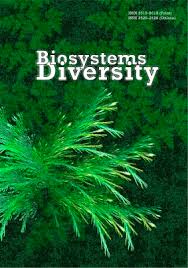Regulation of superoxide dismutase activity in soybean plants by inoculating seeds with rhizobia containing nanoparticles of metal carboxylates under conditions of different water supply
Regulation of superoxide dismutase activity in soybean plants by inoculating seeds with rhizobia containing nanoparticles of metal carboxylates under conditions of different water supply
Author(s): V. V. Morgun, S. Y. Kots, T. P. Mamenko, L. I. Rybachenko, P. P. PukhtaievychSubject(s): Agriculture, Health and medicine and law, Sociobiology
Published by: Дніпропетровський національний університет імені Олеся Гончара
Keywords: Glycine max; Bradyrhizobium japonicum; antioxidant enzymes; symbiotic system; germanium; ferrum; molybdenum;
Summary/Abstract: Soybean is one of the most profitable advanced crops in agricultural production in Ukraine and the world as a whole. Therefore, studies of means of regulation and increase in the adaptive capacity of soybeans in symbiosis with nodule bacteria under the action of unfavourable environmental factors are relevant and should be aimed at the use of complex bacterial compositions involving modern nanotechnological approaches. Nanocarboxylates of ferrum, molybdenum and germanium metals were used as components of rhizobia inoculation suspension for soybean seed treatment to study the effectiveness of their complex effect on the regulation of the activity of the key antioxidant enzyme superoxide dismutase in plants under drought. Various symbiotic systems were used, which included soybean plants and inoculation suspensions based on the active, virulent Tn5-mutant Bradyrhizobium japonicum B1-20 by adding nanoparticles of ferrum, germanium and molybdenum carboxylates to the culture medium in a ratio of 1: 1000. Citric acid was the chelator. A model drought lasting 14 days was created during the period of active fixation of atmospheric molecular nitrogen by root nodules of soybeans in the budding and flowering stages, by means of controlled watering of plants to 30% of the total moisture content. In the stage of bean formation, watering of plants was resumed to the optimal level – 60% of the total moisture content. The control was soybean plants, the seeds of which were inoculated with a suspension of rhizobia without the addition of chelated metals. The following research methods were used in the work – microbiological, physiological and biochemical. According to the results, it was found that when nanoparticles of carboxylates of ferrum, molybdenum and germanium were added to the inoculation suspension of rhizobia, there was an increase in superoxide dismutase activity in root nodules and a decrease in soybean leaves under optimal water supply conditions of plants. This indicates the initial changes in the activity of the antioxidant enzyme in these symbiotic systems, induced by the influence of chelated metals in combination with the rhizobia of the active Tn5-mutant B. japonicum B1-20. Prolonged drought induced an increase in the overall level of superoxide dismutase activity in soybean nodules and leaves, compared to plants grown under optimal watering conditions. The symbiotic system formed by soybeans and B. japonicum with molybdenum carboxylate nanoparticles was the most sensitive to long-term drought exposure, compared to two other soybean-rhizobial symbioses using ferrum and germanium nanocarboxylates. This was manifested in the unstable reaction of the enzyme to the action of drought – suppression or intensification of the level of its activity in the root nodules and leaves of soybeans inoculated with rhizobia containing molybdenum carboxylate nanoparticles. In symbiotic systems with the participation of germanium and ferrum nanocarboxylates, slight changes were revealed in superoxide dismutase activity in root nodules and leaves of plants during drought and restoration of enzyme activity to the level of plants with optimal watering after water stress. It is concluded that the addition to the culture medium of rhizobia Tn5-mutant B1-20 of nanocarboxylates of germanium or ferrum is an effective means of regulating the activity of the antioxidant enzyme superoxide dismutase in soybean root nodules and leaves, which can contribute to an increase in the protective properties and adaptation of plants to the action of dehydration.
Journal: Biosystems Diversity
- Issue Year: 29/2021
- Issue No: 1
- Page Range: 33-38
- Page Count: 6
- Language: English

